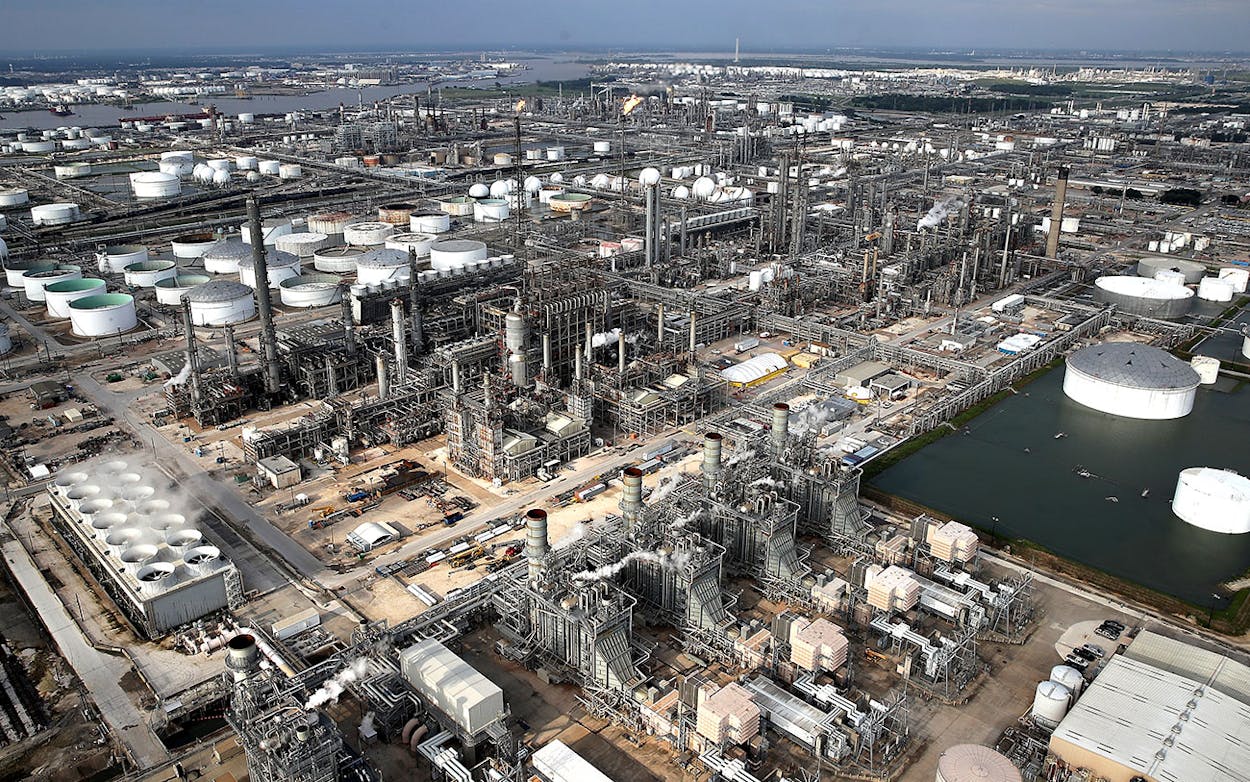The oil and gas refineries that drive Houston’s economy (and make it the energy capital of the world) are also creating a much more tangible and immediate effect in the wake of the storm.
A 6.3 million-gallon fuel storage tank overturned in the flooding and leaked “unspecified amounts” of gasoline into the city, according to Houston Public Media. Since August 25, when the rains first started falling, 18 incident reports have been filed by oil companies such as Exxon, Valero, and Shell with the Texas Commission on Environmental Quality (TCEQ), reporting emissions of hazardous chemicals such as benzene, butane, sulfur dioxide, and other harmful air pollutants.
Typically, refineries release and burn compounds as a safety measure to relieve pressure in case of a mechanical failure or during other, smaller-scale emergencies, says Michael Poehl, a professor in the University of Texas’s chemical engineering department. Normally, he says, “If you burn it, the only thing that gets released is [carbon dioxide], versus ethylene or benzene or something that’s more harmful to humans, so that’s why you see the flare.”
Because the impact and scale of Harvey was underestimated in Houston, the refineries had to be shut down quickly. “To save the plant and the equipment, you have to start shutting down three days out,” says Poehl, who previously worked as a plant manager in the oil industry. “Three days out before a hurricane hits, hell, it’s out by Mexico or Cuba. It’s a tough call and millions of dollars of expense and lost revenue.”
It’s possible that the plants in Houston didn’t make that call early enough, so safety measures like pollutions controls weren’t enacted properly. “The flares are designed for something like 99 percent combustion,” Poehl says, because typically steam is added to the flare so that there’s more oxygen and a cleaner burn—it’s also expensive to burn off chemicals instead of recovering them in storage facilities. “As you’re pushing stuff around and trying to get ready for a hurricane to hit, you have a limited amount of time,” Poehl explains, and combined with a loss of power, which could have occurred during the storm, it might not be feasible to utilize the usual pollution controls. (Representatives from Exxon and other oil companies were not available for comment.)
Luke Metzger, the director of Environment Texas, was monitoring the emissions from these plants on Tuesday. “We’re within 1.3 million pounds of air pollution from shutdowns of refineries and chemical plants within the last few days,” he said. “To put that in perspective, that’s almost a quarter of the entire illegal pollution released last year in the Houston area last year—a quarter of that pollution in a couple of days.” Metzger was not aware of any regulations regarding the flaring that occurs when plants are shut down quickly.
“When a company has an unexpected release that’s outside the normal operations that they’re permitted for, then they report that to us,” says Andrew Keese, a spokesman for the TCEQ. “They’ll provide an initial report with an explanation of what happened, maybe it was a maintenance issue, maybe it was you know, Hurricane Harvey.” (Agency staff members were not available to speak about regulations of flaring, due to emergency responses in areas affected by the storm.)
Keese says that the estimates of pollution currently in the TCEQ’s database are likely higher than expected, since underreporting could lead to fines from the agency.
Residents of the city who had not evacuated and were sheltering in place reported smelling sweet odors and gasoline, according to Yvette Arrellanos, the research and policy liaison for the Texas Environmental Justice Advocacy Service. Communities closest to the refineries are more often than not low-income and minority communities, and residents are disproportionately impacted by the environmental damages from the oil and gas industry, even without catastrophic storms.
- More About:
- Energy






